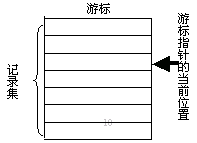每一个游标必须有四个组成部分这四个关键部分必须符合下面的顺序;
1.DECLARE 游标
2.OPEN 游标
3.从一个游标中FETCH 信息
4.CLOSE 或DEALLOCATE 游标 通常我们使用DECLARE 来声明一个游标声明一个游标主要包括以下主要内容:
游标名字
数据来源(表和列)
选取条件
属性(仅读或可修改)
其语法格式如下:
DECLARE cursor_name [INSENSITIVE] [SCROLL] CURSOR
FOR
select_statement
[FOR {READ ONLY | UPDATE [OF column_name [,...n]]}]
其中:
cursor_name 指游标的名字。 INSENSITIVE
游标指针示意图

详细:
1.定义一个标准游标:
declare mycursor cursor for select * from yuangong
2.定义一个只读游标:
declare mycursor cursor for select * from yuangong for read only
3.定义一个可写游标:
declare mycursor1 cursor for select * from yuangong for update of
姓名,性别,年龄,基本工资,奖金,所得税,应发工资
注: scroll 只能对只读游标起作用
4.打开游标:open 游标名 如:
declare mycursor cursor for select * from
yuangong
open mycursor
5.从游标中取数据:fetch,默认情况下,指针指向第一条记录之前
移动记录指针的方法:
NEXT 下移一条记录
prior 上移一条记录
first 第一条记录
LAST 最后一条记录
absolute n 绝对记录 第N条记录 取数据语法:
fetch next|prior|first|last|absolute n from 游标名 [into 变量名列表]
6.关闭游标: close 游标名
暂时关闭游标,还可再使用OPEN打开.
7.释放游标: deallocate 游标名 从内存中清除游标.如果还想使用,必须再次声明.
对当前游标状态进行判断:
8. @@fetch_status 如果返回是0,说明当前操作是成功的.否则是失败的.
0 FETCH 语句成功。
-1 FETCH 语句失败或此行不在结果集中。
-2 被提取的行不存在。
举例1: 利用游标从学生表中逐条读取所有数据:
declare @i INT
DECLARE @TN CHAR(8),@FU CHAR(20
)
declare mycursor cursor for select sno,sname from
student
open
mycursor
select @i=count(*) from
student
while @@fetch_status=0 and @i>1
BEGIN
fetch next from mycursor INTO @TN,@FU
set @i=@i-1
PRINT @TN + ' ' + @FU
END
close
mycursor
deallocate mycursor
结果:
s1001 Jack Dong
s1002 Lucy Dong
s1003 Brezse Dong
s1004 Andy Liu
s1005 Jack Chen
通过游标对读取的数据进行操作,并输出不同的结果:
declare @s_name varchar(20),@c_name VARCHAR(64),@sc_core int
declare my_cur cursor for select
sname,cname,scgrade
from student s, course c, studentCourse sc WHERE s.sno=sc.sno AND c.cno=
sc.cno
open
my_cur
print space(27)+'2007年计算机专业考试系统'
fetch next from my_cur into @s_name,@c_name,@sc_core
while @@fetch_status=0
begin
if @sc_core<60
begin
print space(20)+@s_name+ @c_name +':不及格 '
end
else
begin
if @sc_core >=60 and @sc_core <70
begin
print space(20)+@s_name + @c_name +':及格 '
end
else
begin
if @sc_core>=70 and @sc_core<80
begin
print space(20)+@s_name + @c_name +':良好'
end
else
begin
print space(20)+@s_name + @c_name +':优秀'
end
end
end
fetch next from my_cur into @s_name,@c_name,@sc_core
end
close
my_cur
deallocate my_cur
结果:
2007年计算机专业考试系统
Jack Dong C++ 程序设计:及格
Jack Dong 操作系统:良好
Lucy Dong C++ 程序设计:优秀
Lucy Dong 计算机组成原理:良好
Brezse Dong C++ 程序设计:优秀
Brezse Dong 面向对象的程序设计方法:不及格
Andy Liu 操作系统:不及格
Andy Liu 计算机组成原理:优秀
使用游标时应注意的问题:
(1) 尽管使用游标比较灵活,可以实现对数据集中单行数据的直接操作,但游标会在下面几个方面影响系统的性能:
-使用游标会导致页锁与表锁的增加
-导致网络通信量的增加
-增加了服务器处理相应指令的额外开销 (2) 使用游标时的优化问题:
-明确指出游标的用途:for read only或for update
-在for update后指定被修改的列



















